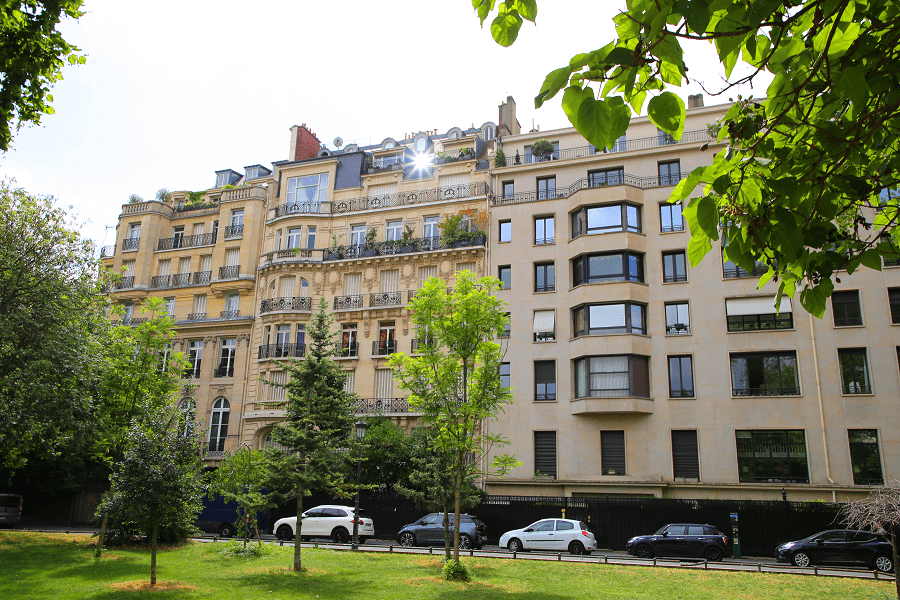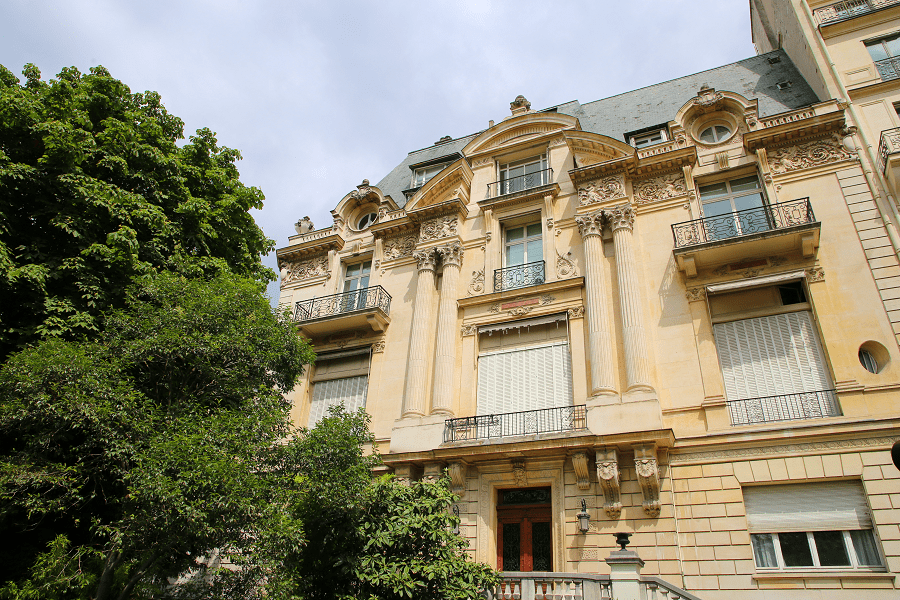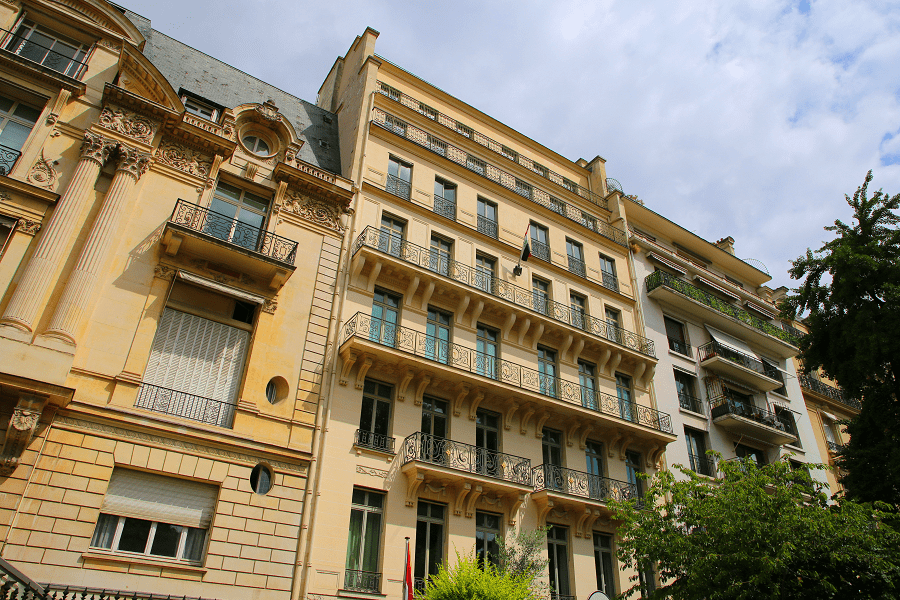Avenue Foch is a street in the 16th arrondissement in Paris (France). The avenue takes its name in honor of Ferdinand Foch (1851-1929), Marshal of France and Generalissimo of the Great War.
This route begins at Place Charles-de-Gaulle (formerly named “Place de l’Etoile”, Arc de Triomphe) and ends at Porte Dauphine (Place du Maréchal-de-Lattre-de-Tassigny). It is one of the twelve avenues of the Étoile and one of the most prestigious Parisian areas.
Avenue Foch is 1,300 meters long and 120 meters wide thanks to the gardens which line it from one end to the other and which make it the widest avenue in the capital. Another particularity, unique to Paris: its large bridle paths, located between the roadway and the gardens, are not paved (they once allowed riders to reach the Bois de Boulogne on horseback, which is at its western end, on the Porte Dauphine side).
It crosses Avenue de Malakoff and Avenue Raymond-Poincaré in its center.
At Porte Dauphine, it forms the triangle with Avenue Bugeaud and Boulevard Flandrin which was named Place du Paraguay by decree of February 13, 1962.
The Avenue was constructed during the reign of Emperor Napoleon III, as part of the grand plan for the reconstruction of Paris conducted by Napoleon’s prefect of the Seine, Baron Haussmann. It was designed to connect the Place de l’Étoile with another important part of Haussmann’s plan, the Bois de Boulogne, the new public park on the west end of the city.
The Gardens of Avenue Foch occupy a space of 6.62 hectares, within the avenue’s dimensions (1,200 metres long and 140 metres wide). In addition to the 4,000 trees that line the avenue, the garden was originally planted with 2,400 different species of trees and plants, making it, as Alphand wrote, “a kind of arboretum”. Many of the original trees can still be found in the gardens, including a chestnut tree from India, 4.7 metres in circumference, an elm tree from Siberia, 3.8 metres in circumference, along with a giant Catalpa tree, 3.5 metres in circumference, all three dating from 1852.
Main sights
No 1 bis: Armand Salacrou lived there.
No 2 bis: “Le Duplex” nightclub.
No. 3: the novelist Gérard de Villiers lived there
No 7: the novelist Paul Hervieu died there in 1915; a plaque pays tribute to him.
No 8: “Terminal Foch” cinema. Opened in 1970 underground, it is also accessible via the car park, the “Air Inter Foch Shopping” center and the Charles-de-Gaulle – Étoile RER station. It closed in 1976.
No. 9 (corner rue de Traktir): high-end housing building designed in 1950 by the architect Jean Boudriot.
No. 12: Breteuil hotel, built by the architect Ernest Sanson in 1902, for Henry Le Tonnelier de Breteuil. Today it houses the Irish embassy.
No. 19: Ephrussi de Rothschild hotel. Hotel of the banker Maurice Ephrussi (1849-1916) and his wife, née Béatrice de Rothschild (1864-1934). Today, the Angolan embassy in France occupies the place.
No. 17: the deputy of the Third Republic and businessman Edmond Bartissol died there on August 16, 1916.
No. 22: the art dealer Paul Guillaume (1891-1934) settled at this address with his wife Domenica at the end of the 1920s, in an apartment of 600 m2 (it was still Avenue du Bois at the time).
No. 23: the poet Renée Vivien (1877-1909) lived there. In the 1920s, the building housed the Chilean legation.
No. 31 bis: location of the general commissariat for Jewish questions during the occupation by Germany during the Second World War.
No. 33: on January 23, 1978, Baron Édouard-Jean Empain was kidnapped in front of his home located at no. 33, giving rise to the Empain affair.
No. 34 (and 3, rue Le Sueur): Hôtel Blumenthal, also known as Montmorency, built in 1900 by Henri-Paul Nénot, on land acquired from the La Nationale insurance company by the American merchant of German origin Ferdinand Blumenthal (1847-1914).
No. 38: seven-story, 3,600 m2 mansion belonging to former Syrian vice-president Rifaat al-Assad, uncle of President Bashar Al-Assad; on June 17, 2020, the Paris criminal court sentences Rifaat al-Assad to 4 years in prison, for money laundering in an organized gang embezzling Syrian public funds and also orders the confiscation of his real estate, considered “ill-gotten property”.
No. 40: the poet and playwright Henry Bataille (1872-1922) lived there. In the same district, a square pays homage to him.
No. 41 (corner with avenue Raymond-Poincaré): building designed in 1907 by the architect André Arfvidson, with a colonnade loggia on the fourth floor, signed to the right of the entrance. There we find the headquarters of the Yacht Club de France, founded in 1867, as well as the residence of the Israeli ambassador to France.
No. 42: private mansion of Teodoro Nguema Obiang Mangué (son of the president of Equatorial Guinea), confiscated by French justice. In September 2011, as part of the so-called “ill-gotten gains” affair, the police seized eleven luxury vehicles (Bugatti, Ferrari, Maserati, Porsche, Rolls-Royce, etc.). In 2012, the building was reassigned to the country’s diplomatic services, becoming over the course of the decade the headquarters of the Equatorial Guinea embassy in France.
No. 43 (corner rue de la Pompe): the former President of the Republic Gaston Doumergue (1863-1937) moved there in 1934, on the first floor, shortly before his death. His neighbor, on the ground floor, is the Belgian ambassador, Baron Gaiffier d’Hestroy.
No. 46: Vera Nimidoff held a literary salon frequented by Paul Valéry, Jean Cocteau, Louis Barthou, Prince Pierre de Polignac, François Mauriac, Henry Bordeaux, Abel Bonnard, Anna de Noailles, Léon-Paul Fargue, Georges Henri Rivière and Henri by Régnier.
No. 50: Françoise Hardy and Jacques Dutronc lived here.
No 52: Property of the clan of Gabonese President Ali Bongo.
No 53: Art Deco building from 1939 built by architect Charles Abella.
Transport
The Paris metro and RER stations are located on the avenue:
Charles de Gaulle – Étoile (lines (M) (1) (2) (6) and line (RER) (A));
Porte Dauphine (the terminus of line (M) (2));
Avenue Foch (line (RER) (C)) located at the corner with Boulevard Flandrin (Porte Dauphine).
See more:
















